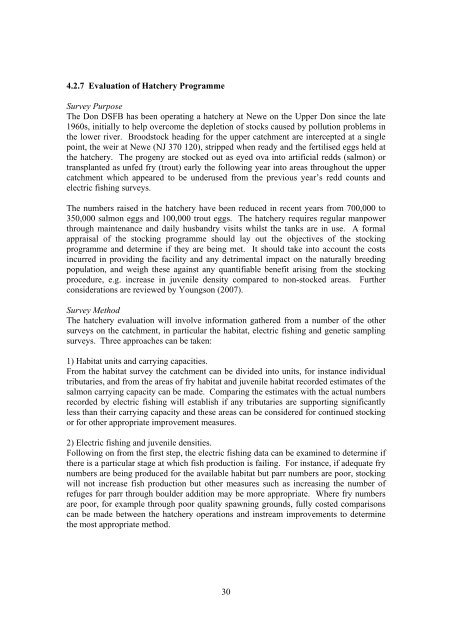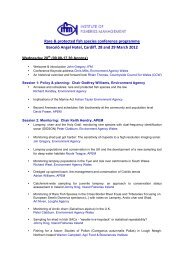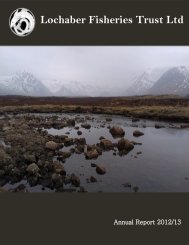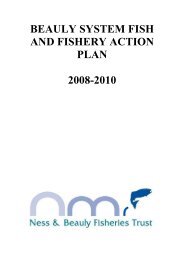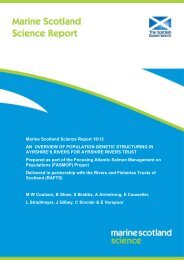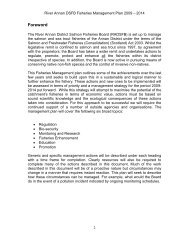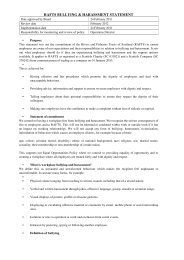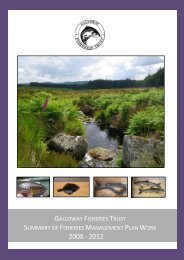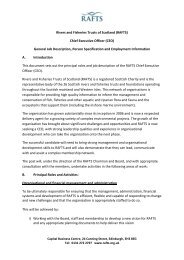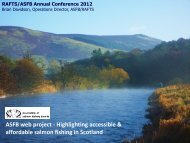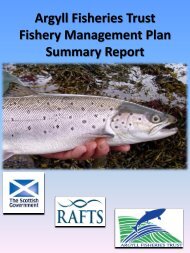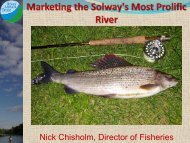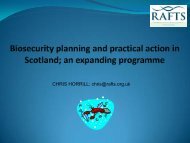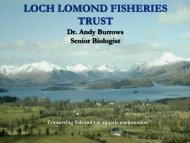Create successful ePaper yourself
Turn your PDF publications into a flip-book with our unique Google optimized e-Paper software.
4.2.7 Evaluation of Hatchery ProgrammeSurvey PurposeThe <strong>Don</strong> DSFB has been operating a hatchery at Newe on the Upper <strong>Don</strong> since the late1960s, initially to help overcome the depletion of stocks caused by pollution problems inthe lower river. Broodstock heading for the upper catchment are intercepted at a singlepoint, the weir at Newe (NJ 370 120), stripped when ready and the fertilised eggs held atthe hatchery. The progeny are stocked out as eyed ova into artificial redds (salmon) ortransplanted as unfed fry (trout) early the following year into areas throughout the uppercatchment which appeared to be underused from the previous year’s redd counts andelectric fishing surveys.The numbers raised in the hatchery have been reduced in recent years from 700,000 to350,000 salmon eggs and 100,000 trout eggs. The hatchery requires regular manpowerthrough maintenance and daily husbandry visits whilst the tanks are in use. A formalappraisal of the stocking programme should lay out the objectives of the stockingprogramme and determine if they are being met. It should take into account the costsincurred in providing the facility and any detrimental impact on the naturally breedingpopulation, and weigh these against any quantifiable benefit arising from the stockingprocedure, e.g. increase in juvenile density compared to non-stocked areas. Furtherconsiderations are reviewed by Youngson (2007).Survey MethodThe hatchery evaluation will involve information gathered from a number of the othersurveys on the catchment, in particular the habitat, electric fishing and genetic samplingsurveys. Three approaches can be taken:1) Habitat units and carrying capacities.From the habitat survey the catchment can be divided into units, for instance individualtributaries, and from the areas of fry habitat and juvenile habitat recorded estimates of thesalmon carrying capacity can be made. Comparing the estimates with the actual numbersrecorded by electric fishing will establish if any tributaries are supporting significantlyless than their carrying capacity and these areas can be considered for continued stockingor for other appropriate improvement measures.2) Electric fishing and juvenile densities.Following on from the first step, the electric fishing data can be examined to determine ifthere is a particular stage at which fish production is failing. For instance, if adequate frynumbers are being produced for the available habitat but parr numbers are poor, stockingwill not increase fish production but other measures such as increasing the number ofrefuges for parr through boulder addition may be more appropriate. Where fry numbersare poor, for example through poor quality spawning grounds, fully costed comparisonscan be made between the hatchery operations and instream improvements to determinethe most appropriate method.30


